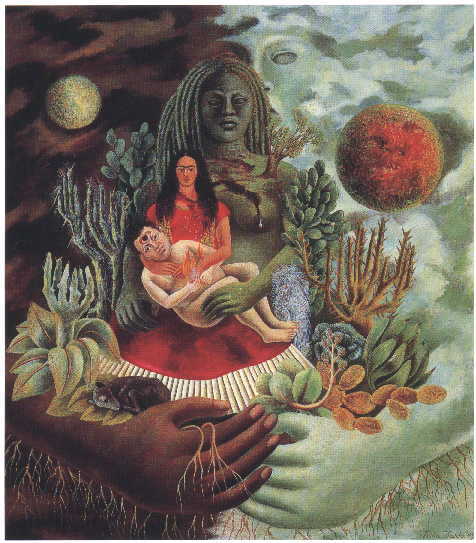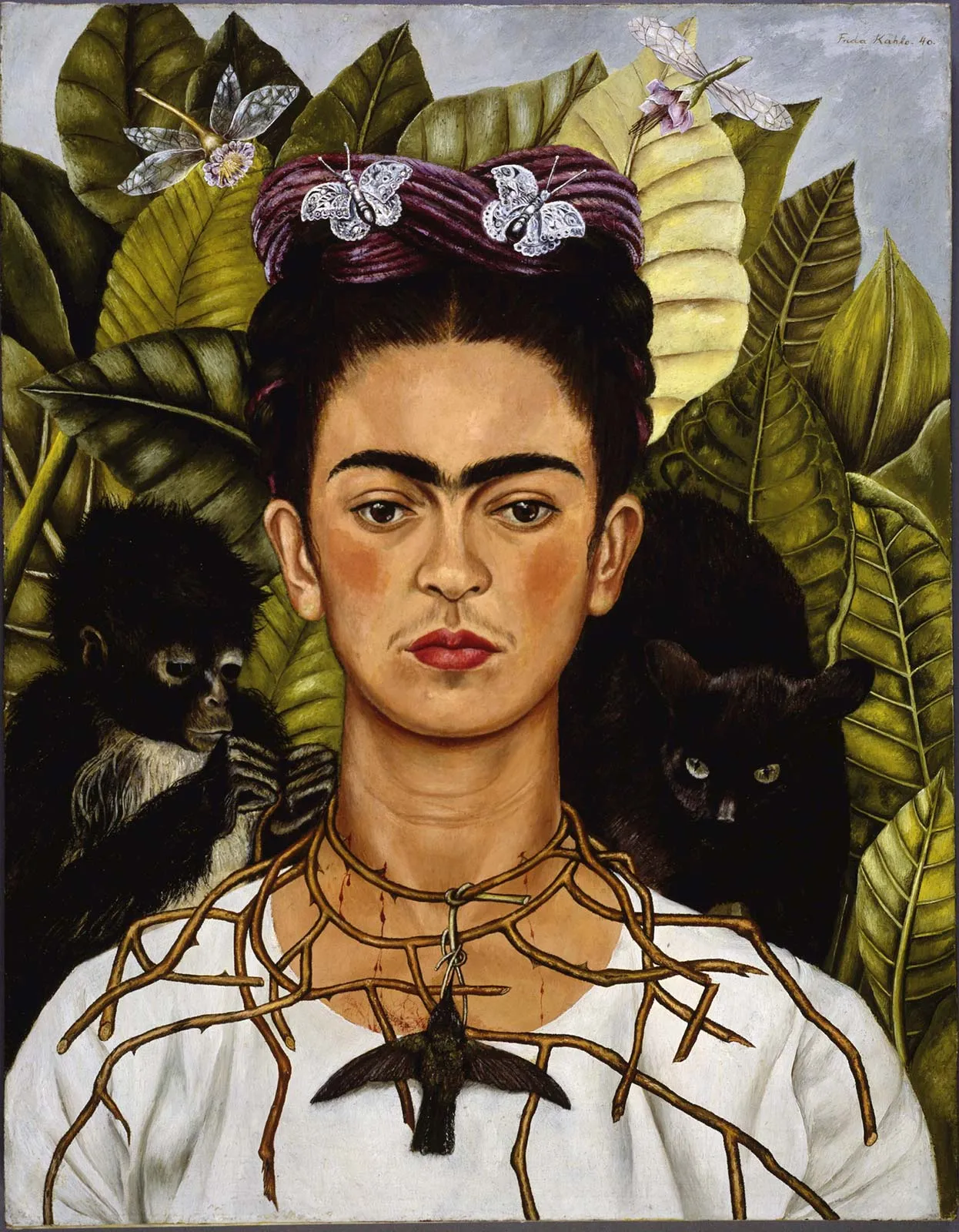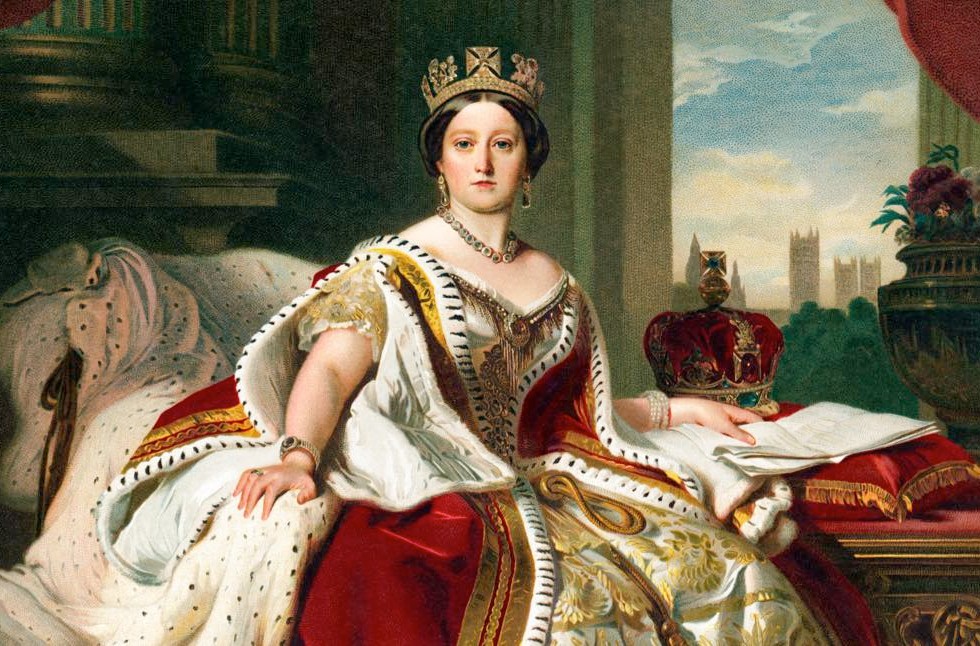
"The Love Embrace of the Universe, the Earth (Mexico), Me, Diego, and Mr. Xolotl," by Frida Kahlo, 1949.
In the lower left of Frida Kahlo‘s painting, “The Love Embrace of the Universe” (above), a little dog is sound asleep in a huge hand. The dog is Frida Kahlo’s favorite pet dog, Mr. Xolotl. Mr. Xolotl (show-low -tul) was a xoloitxcuintli (show-low-eats-queen-tlee) dog. Frida had several of these unusual-looking dogs, a hairless breed with an ancestry that is traceable back 3,000 years to the Aztecs, hence their appeal to Frida, enormously proud of her MesoAmerican heritage. Xolos (show-lows), for short, are related to Mexican hairless chihuahuas. The Aztecs both revered and ate xolos.

"Frida Kahlo and her Itzcuintli Dogs," photo by Lola Alvarez Bravo, 1944
Nowadays, xolos are prized for the enormous amount of heat their bodies generate, although they do not have a higher-than-average body temperature. As a result, many sufferers of rheumatism and arthritis keep xolos as pets, claiming the dogs relieve their pain by acting as canine heaters.
The xolos are sometimes referred to as Colima dogs. They may range in size from 3 pounds to 60.



















Dear Ms. Rogers,
I am the blog intern at Oxford University Press and I have become a reader of your blog. I found your recent post about Frieda Kahlo to be very interesting. I’ve never seen that painting before, but now that I have—I love it. Thank you for directing my attention to such a fabulous work of art.
Over at the OUP blog we have a new series of posts that I think you and your readers might want to take a look at. For the first post (http://blog.oup.com/2009/05/ancient_balkans/ ), we’ve excerpted one of the four books in the series–Andrew Baruch Wachtel’s The Ancient Balkans. In the excerpt, Wachtel writes of the very beginning of Balkan civilization, particularly the society’s innovations including domesticated wheat and beans, clay pottery fired for storage as well as the domestication of goats and sheep. Wechtel also relates the early days of the Balkan civilization to modern languages—traces can be heard in today’s Romanian, food—wine and olives, and also to the modern political problems of the Balkans, including the ongoing conflict between the Macedonian Republic and Greece over who has the right to Alexander the Great’s legacy.
For the second post (http://blog.oup.com/2009/05/south-africa/ ), we’ve excerpted Iris Berger’s South Africa. Berger relates the cultural exchange that occurred in South Africa after the arrival of the Dutch East India Company and other Europeans looking for wealth in the spice trade. Berger offers a personal glimpse into the effects the spice trade had on South Africa by relating the story of Krotoa, a young girl who was taken in as a servant, and then renamed Eva, by a Dutch merchant. Once she learned to speak Dutch, Eva became a valuable link between the Dutch and South African cultures that helped trading activities to run more smoothly and peacefully. Berger then relates the tragic end to Eva’s story to the larger social context of the divisions of the early colonial era in Africa.
There will be two upcoming posts covering the next two books in the series—Southeast Asia in World History and Technology in World History. The series of four posts offer a unique glimpse into history that bridges cross-cultural gaps between the past and the modern day.
Wachtel on the Ancient Balkans: http://blog.oup.com/2009/05/ancient_balkans/
Berger on South Africa:http://blog.oup.com/2009/05/south-africa/
Thank you for reading and I hope that you and your readers enjoy the posts.
Regards,
Megan Branch
Blog Intern
Oxford University Press
198 Madison Ave
New York, NY
LikeLike
Megan, thank you for the wonderful information. I’ve posted it for my readers and I’m sure you will be hearing from them. Please keep reading Lisa’s History Room.
LikeLike
great site! i referenced it in the Xolo wiki page: https://en.wikipedia.org/wiki/Mexican_Hairless_Dog#cite_note-16
LikeLike